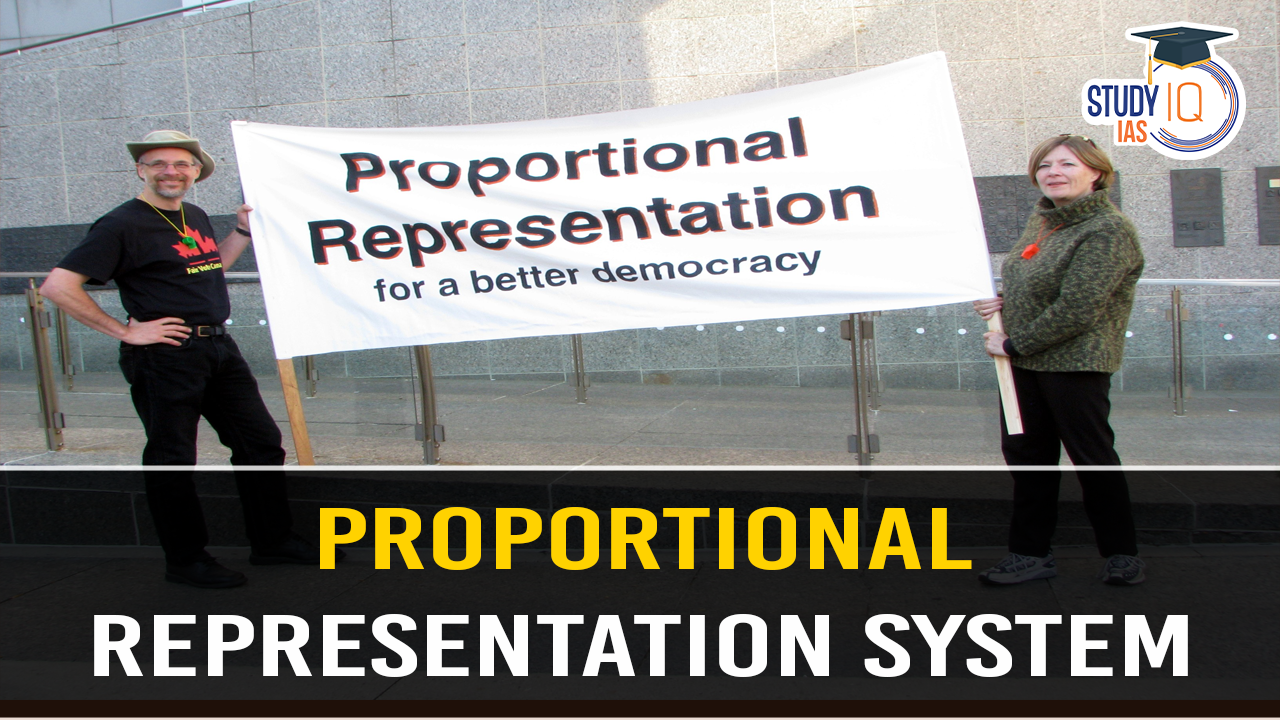Table of Contents
Context: Under the First Past the Post (FPTP) system, where political parties can win a disproportionate number of seats relative to their actual vote share, leading to over or underrepresentation in legislative bodies.
| Recent Election Reference |
|
Electoral Systems
First Past the Post (FPTP) System
- About: The FPTP system elects the candidate who receives the most votes in a single constituency.
- Usage: In the elections to the Lok Sabha and Legislative Assemblies
Advantages:
- Simplicity and Speed: FPTP is straightforward for voters to understand and for election officials to count, facilitating quick results.
- Stability: Often results in a clear majority for one party, promoting governmental stability and decisive governance.
- For instance, the NDA winning 293 seats in the recent Indian Lok Sabha elections enables strong leadership and policy implementation.
- Constituency Representation: Ensures that each geographic area has a dedicated representative, which can strengthen the accountability of elected officials to their local voters.
Disadvantages:
- Disproportionate Representation: Can lead to a mismatch between the percentage of national votes a party receives and the number of seats they obtain in the legislature.
- For example, in the 2024 Indian general elections, NDA received 43.3% of the vote but won a higher proportion of seats (293 out of 543).
- Marginalisation of Smaller Parties: Favours larger parties and often leaves smaller parties and minority interests underrepresented unless they have concentrated regional support.
- Wasted Votes: Votes cast for losing candidates or excess votes for winning candidates do not contribute to the final result, potentially leading to voter dissatisfaction and lower turnout.
Proportional Representation System
- About: Proportional Representation (PR) allocates seats based on the percentage of votes each party receives.
- Usage: For the election of President, Vice-President, and members to the Rajya Sabha.
- Types: Common types include the ‘party list PR’ system where parties receive seats in proportion to their overall vote share, with a typical threshold of 3-5% to qualify for seats.
Advantages:
- Fair Representation: More accurately reflects the will of the electorate in the composition of the legislature.
- For instance, under a PR system, the INDIA bloc and other regional parties in the 2024 elections would receive seats more commensurate with their vote shares.
- Diversity: Encourages a multiplicity of political parties, thereby promoting a more diverse political discourse and representation of a broader spectrum of views and interests.
- Reduced Wastage of Votes: Almost all votes contribute to the final result, enhancing voter satisfaction and engagement.
Disadvantages:
- Potential for Fragmentation: Can lead to a fragmented parliament with multiple small parties, making it difficult to form stable governments. This can result in frequent elections or coalition governments that may be unstable.
- Complexity: The system can be complex for voters to understand, especially in variants like the Mixed Member Proportional (MMP) system, where voters may have multiple votes for different aspects of the representation.
- Encourages Extremism: By allowing smaller parties to gain seats, PR might enable fringe or extremist parties to have a platform, potentially leading to polarised politics.
Mixed Member Proportional Representation (MMPR) System
- The MMPR system is an electoral system that combines elements of the First Past the Post (FPTP) system and the Proportional Representation (PR) model to elect representatives in legislative bodies.
How MMPR Works?
- Constituency Vote: Each voter casts one vote for a candidate to represent their local electoral district, similar to the FPTP system. The candidate with the most votes in each district wins that district’s seat.
- Party Vote: Voters also cast a second vote for a political party, independent of their candidate choice. This vote determines the overall proportion of seats each party should have in the legislature.
- Allocation of Seats:
- Direct Seats: These are filled by the candidates who win the constituency vote in each district.
- List Seats: Additional seats are allocated to parties based on their share of the party votes, ensuring that the total seats a party holds are proportional to its party vote percentage.
- Overhang and Compensation Seats: If a party wins more direct seats than their proportional share of the party vote would entitle them to, these are called “overhang seats.” To maintain proportionality across the legislature, additional “compensation seats” may be awarded to other parties.
Examples of MMPR Implementation
- Germany: Utilises MMPR for Bundestag elections, combining direct constituency representatives with party list seats.
- Each voter has two votes: one for their preferred candidate and another for a party list.
- New Zealand: Follows an MMPR system where the Parliament has both constituency seats and list seats, with a threshold of 5% or one constituency seat for list representation.
Advantages and Disadvantages
Advantages:
- Fair Representation: Bridges the gap between voter preference and legislative representation, ensuring that smaller parties gain proportional representation.
- Stability and Accountability: Maintains constituency-based representatives, fostering stability and local accountability in governance.
Disadvantages:
- Complexity: The dual voting system and the calculations for seat allocation add layers of complexity for voters and electoral administrators.
- Perception Issues: The differentiation between directly elected and list-elected representatives can lead to perceptions of a “two-tier” legislature, where some members are viewed as less legitimate.
Recommendations
- The 170th report (Reform of the electoral laws (1999)) by India’s Law Commission suggested experimenting with MMPR, potentially filling 25% of Lok Sabha seats by PR, considered at the State/Union Territory level.
- Upcoming delimitation based on post-2026 census data could consider increasing Lok Sabha seats, incorporating PR to ensure fair representation across India’s diverse regions.
- Incremental seats or at least 25% of total seats might be allocated using MMPR to address regional disparities and enhance representation fairness.


 Utkal Divas 2025: Odisha Foundation Day ...
Utkal Divas 2025: Odisha Foundation Day ...
 Transfer and Removal Process for High Co...
Transfer and Removal Process for High Co...
 List of Military Exercises of India 2024...
List of Military Exercises of India 2024...





















